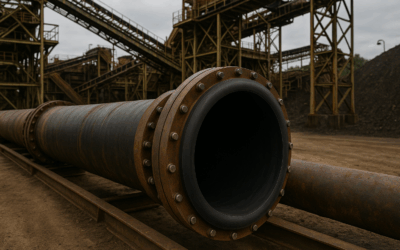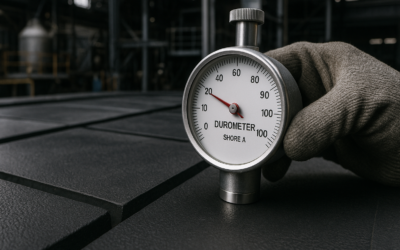Rubber linings play a vital role in industrial applications, providing a reliable shield to protect equipment from corrosion, abrasion, and chemical damage. However, despite their durability, rubber linings are not immune to failure. Improper installation, poor maintenance, or choosing the wrong materials can lead to damage.
Let’s explore the five most common reasons for rubber lining failures and how to prevent them. Whether you’re installing new linings or maintaining existing ones, these insights will help you ensure long-lasting, reliable performance.
How to Prevent Rubber Lining Failures
1. Improper Installation
One of the most common causes of rubber lining failures is improper installation. When linings are not installed correctly, they can fail prematurely, leading to costly repairs and equipment downtime. Some common installation issues include:
- Misaligned installation that causes uneven stress distribution.
- Overtightening, which can compromise the integrity of the lining.
- Failure to follow manufacturer guidelines, resulting in suboptimal performance.
Prevention Tips:
- Hire Certified Professionals: Always rely on certified installers who understand the technical requirements of rubber lining applications.
- Follow Manufacturer Specifications: Ensure the installation process follows the manufacturer’s guidelines, including curing times, alignment procedures, and adhesive application.
- Conduct Quality Checks: Inspect the lining during and after installation to confirm proper alignment, adhesion, and overall fit. Testing for uniform thickness and secure adhesion is also essential.
2. Chemical Incompatibility
Rubber linings protect equipment from chemical exposure, but not all linings are suited for every chemical environment. Using a material that lacks the necessary chemical resistance can result in rapid degradation, such as:
- Swelling from exposure to incompatible chemicals.
- Brittleness caused by prolonged contact with harsh substances.
- Cracking or delamination, leaving the equipment vulnerable to further damage.
Prevention Tips:
- Conduct a Chemical Analysis: Before selecting a rubber lining, thoroughly evaluate the chemicals it will encounter, including their concentration and temperature. This ensures the chosen lining material can withstand the specific environment.
- Consult With Experts: Choose a certified installer who understands the chemical compatibility of rubber linings and can recommend additional coatings or protective layers if needed.
3. Temperature Extremes
Temperature extremes are a significant factor in the deterioration of rubber linings. Operating equipment in conditions outside the recommended temperature range can lead to:
- Softening of the rubber when exposed to excessive heat, compromising its structural integrity.
- Hardening or cracking in extremely cold temperatures, making the lining brittle and prone to failure.
- Loss of elasticity, resulting in reduced protective performance and increased susceptibility to damage.
Prevention Tips:
- Choose the Right Material: Select rubber linings specifically designed for the temperature range of your application. For example:
- Use materials like natural rubber for moderate temperatures.
- Invest in EPDM or other heat-resistant rubbers for high-temperature environments.
- Choose rubber formulations that maintain flexibility at low temperatures for cold weather.
- Monitor Temperatures: Regularly track operating temperatures to ensure they remain within the rubber lining’s tolerance range.
- Implement Protective Measures: Insulate or shield equipment to minimize exposure to extreme heat or cold, reducing stress on the lining.
4. Insufficient Adhesion
Adhesion is critical to the performance of rubber linings. If the surface to be lined is not adequately prepared, the rubber may not bond correctly, leading to:
- Delamination, where the lining separates from the substrate.
- Separation, which exposes equipment to potential corrosion, abrasion, or chemical damage.
- Premature failure of the lining due to weak bonding.
Prevention Tips:
- Proper Surface Preparation: Use abrasive blasting to remove contaminants like rust, grease, or old coatings. Clean the surface with the recommended solvents or cleaners for optimal adhesion conditions.
- Prime the Surface: Apply the appropriate primer to create a strong bond between the substrate and the rubber lining.
- Conduct Adhesion Tests: Perform pull tests or other adhesion verification methods during and after installation to confirm a secure bond.
5. Incorrect Thickness
The thickness of a rubber lining plays a critical role in its performance and longevity. Incorrect thickness can lead to several issues:
- Too Thin: A lining that is too thin may wear out quickly, leaving the equipment unprotected and prone to damage.
- Too Thick: Excessive thickness can reduce flexibility and create stress points that lead to cracking or delamination.
Prevention Tips:
- Determine the Appropriate Thickness: Evaluate the specific conditions of the application, including:
- Abrasion levels for high-wear environments.
- Pressure requirements in high-stress systems.
- Chemical exposure to ensure the lining can withstand the environment without degrading.
- Follow Industry Standards: Refer to manufacturer recommendations and industry guidelines to ensure the thickness meets operational demands.
- Rely on Certified Professionals: Work with experienced installers who can measure and verify the correct thickness during installation.
Protect Your Rubber Lining With US RUBBER
Understanding and addressing common causes of rubber lining failures, such as improper installation and chemical incompatibility, can help you avoid costly downtime and ensure reliable performance.
At US RUBBER, we specialize in providing durable rubber linings, expert installation, and 24/7 repair services. Whether you need a new lining or expert advice on maintaining existing ones, our team has you covered.
Contact US RUBBER today for professional consultation, high-quality materials, and solutions tailored to your specific needs.







